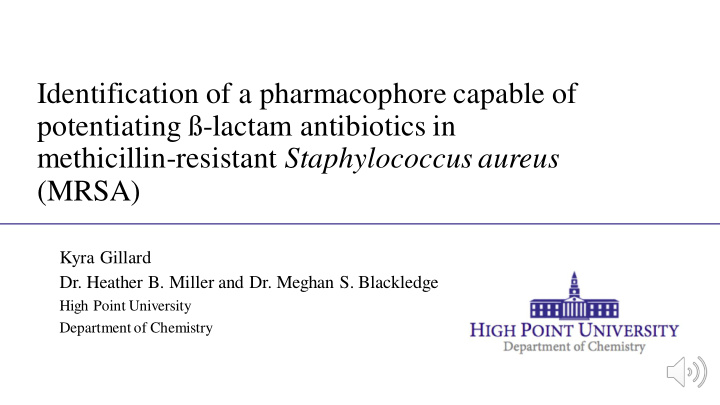



Identification of a pharmacophore capable of potentiating ß-lactam antibiotics in methicillin-resistant Staphylococcus aureus (MRSA) Kyra Gillard Dr. Heather B. Miller and Dr. Meghan S. Blackledge High Point University Department of Chemistry
Antibiotic Resistance Clatworthy et. al. (2007) Nat. Chem. Biol. 3 : 541-548
Methicillin-Resistant Staphylococcus aureus (MRSA) • Kills over 20,000 people a year • Employs several virulence factors, including antibiotic resistance • Giving it increased infectivity • Making it extremely hard to treat https://www.staph-infection-resources.com/recurring/mrsa-reinfection/
Ways to Combat Resistance 1. Build bigger stronger antibiotics • Development of new antibiotics 2. Sneak antibiotics into cells • Targeting resistance mechanisms
Antibiotic Adjuvants • A Trojan horse approach to combating resistance • Small molecules combined with antibiotics • Do not have any antibiotic activity • Non-toxic
Repotentiation is β -Lactam Specific + Amoxapine (150µM) Antibiotic MIC (µg/mL) MIC (µg/mL) Fold Reduction Oxacillin 32 2 16 Ampicillin 32 4 8 S. aureus Penicillin 16 1 16 A TCC 43300 Cefazolin 16 0.5 32 V ancomycin 2 2 1 MIC 600 µM Fold Reduction = MIC Antibiotic MIC Antibiotic+Compound Wilson, T Blackledge, M Viguiera, P Heliyon 2018
FDA-Approved Antidepressants + 150 µM Fold + 75 µM Fold Compound MIC (µg/mL) Reduction MIC (µg/mL) Reduction Amoxapine 2 16 8 4 Loxapine 8 4 32 1 S. aureus Clothiapine - - 4 4 ATCC 43300 Clozapine 4 8 32 1 Olanzapine 32 1 32 1 Gillard, K Miller, H Blackledge, M Chemical Biology and Drug Design submitted
MRSA Resistance Mechanisms • Three methods for resistance 1. Efflux pumps Generate β -lactamase by blaZ 2. • Breaks down β -lactam antibiotics 3. Turn on penicillin-binding protein 2A (PBP2A) via mecA • Has reduced affinity for β -lactam antibiotics
Regulation of the bla and mec operons in MRSA Gillard, K Miller, H Blackledge, M Chemical Biology and Drug Design submitted
Nitrocefin Hydrolysis Assay
Whole Cell Nitrocefin Hydrolysis in MRSA 43300 120 A 486 (% of Control) 100 80 60 40 20 0 - amoxapine + 75 uM amoxapine + 150 uM amoxapine - oxacillin + 4ug/ml oxacillin Gillard, K Miller, H Blackledge, M Chemical Biology and Drug Design submitted
Whole Cell Nitrocefin Hydrolysis in MSSA 29213 120 A 486 (% of Control) 100 80 60 40 20 0 - amoxapine + 75 uM amoxapine + 150 uM amoxapine - oxacillin + 4ug/ml oxacillin Gillard, K Miller, H Blackledge, M Chemical Biology and Drug Design submitted
Amoxapine Induces Changes in Gene Expression Gillard, K Miller, H Blackledge, M Chemical Biology and Drug Design submitted
Amoxapine Induces Changes in Gene Expression Gillard, K Miller, H Blackledge, M Chemical Biology and Drug Design submitted
Amoxapine Induces Changes in Gene Expression Gillard, K Miller, H Blackledge, M Chemical Biology and Drug Design submitted
Conclusion • Structure activity relationship • Methylation of piperazine ring decreases adjuvant activity • Changing the bridge heteroatom from a ether to a thioether increases activity • Aromatic halogenation may be required • Mechanism of Action • Not inhibiting β -lactamase nor preventing export • Dampening transcriptional response to β -lactam antibiotic treatment • Selectively affects the bla and mec operons
Future directions • Identify the molecular target of amoxapine • Upstream regulator? • BlaR1 and MecR1? • mRNA destabilization? • Expand the structure activity relationship • Synthesize more potent analogs
Acknowledgements • Blackledge lab • Dr. Heather Miller • High Point University Chemistry Department • High Point University Undergraduate Research and Creative Works
Recommend
More recommend